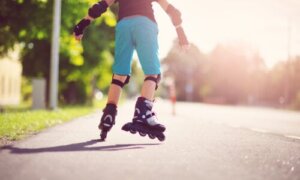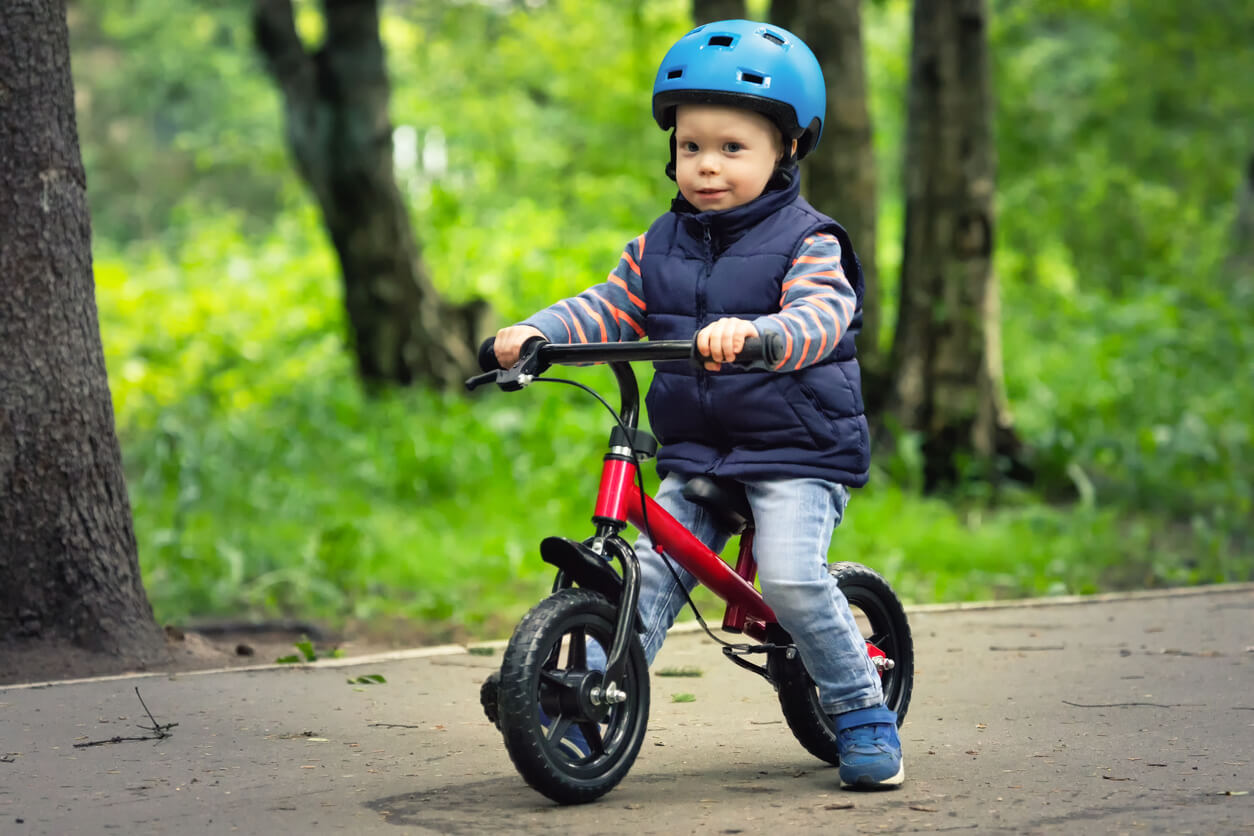Sports on Wheels for Children: What Precautions to Take?


Written and verified by degree in physical education and sports Andrés Felipe Cardona Lenis
The precautions that children should take when practicing sports on wheels is a commitment that the whole family must make.
Normally, little ones prefer not to use safety elements due to the lack of comfort they perceive or even because of how they look. In spite of this, these elements are practically mandatory.
As parents, it’s necessary to motivate children to use these accessories, as well as to implement a series of other precautions so that the little ones can enjoy their sport calmly and safely.
The precautions you should take with wheeled sports
Most wheeled sports are carried out outdoors, so they’re considered a great alternative for children. In addition to this, this type of practice offers numerous physical and psychological benefits, which we can’t ignore.
Another important aspect related to sports on wheels focuses on companionship, as any of these activities can be done with family or friends.
With all of that in mind and in order to obtain as many advantages as possible, it’s necessary to abide by a series of precautions. Below, we’ll show you which are the most relevant precautions you should take.
1. Have the appropriate protective elements
Protective elements stand out as one of the first keys to practicing sports on wheels and perhaps, the most important factor for good practice. Their correct placement and location must be ensured before, during, and after practice, both in children and adults.
Your objective as a parent is to encourage your children to use these elements and to supervise that they’re used in the correct way for which they were designed.
Another aspect you should take into account is the sizing of these accessories, as children are often seen with helmets that are larger than recommended or too small for their dimensions. This is a potentially serious mistake, as it provides a “false” sense of safety, when in fact it can’t effectively prevent injuries.

2. Implement training wheels
Training wheels are recognized as one of the most popular precautionary measures linked to bicycles. This measure has evolved over time and its rigidity has varied to achieve a better and better adaptation to the terrain.
These elements are advisable for those children who are beginners in cycling and even for those who lack balance or are afraid to practice.
As with the safety elements, we recommend you make sure that both the bicycle and the auxiliary wheels are the right size for your child.
3. Make sure that the wheels are the right size for your child
Wheeled sports involve the use of an external element. The most famous are bicycles, roller skates, and skateboards, among others.
Among the most important precautions for practicing sports on wheels is the size of the wheels. Ideally, children should use elements appropriate for their size or the size of their lower limbs.
A clear example of this is evident with skates. If a child wears a pair of skates that are larger than their size, they’re more likely to get injured or fall more easily. The same can happen with bicycles, which are uncomfortable and dangerous if they don’t fit the infant’s body size.
4. Provide them with the appropriate footwear
Not all wheeled sports are carried out with elements on the feet, as is the case with skating. Many practices require constant contact with the ground, which is why footwear is of great importance. With that in mind, you must take into account resistant footwear as well as the size and tastes of the children.
5. Use methodological elements
Sports on wheels carry a certain risk of injury, which is why they should be carried out calmly. It’s even necessary to implement some methodological exercises in order to achieve a slower transition. Depending on the sport your children choose, the method to achieve this will be different.
For example, in the case of skateboarding, much wider boards than usual are used, which allow for slower speeds.

Actively participate in your children’s sports care
As a parent, your fundamental duty is to ensure the safety of your children, no matter what sport they practice. For this reason, we advise you to actively and consistently participate in this practice. And if you don’t know anything about the discipline they choose, try to do some research and stay informed.
The precautions that children should take when practicing sports on wheels is a commitment that the whole family must make.
Normally, little ones prefer not to use safety elements due to the lack of comfort they perceive or even because of how they look. In spite of this, these elements are practically mandatory.
As parents, it’s necessary to motivate children to use these accessories, as well as to implement a series of other precautions so that the little ones can enjoy their sport calmly and safely.
The precautions you should take with wheeled sports
Most wheeled sports are carried out outdoors, so they’re considered a great alternative for children. In addition to this, this type of practice offers numerous physical and psychological benefits, which we can’t ignore.
Another important aspect related to sports on wheels focuses on companionship, as any of these activities can be done with family or friends.
With all of that in mind and in order to obtain as many advantages as possible, it’s necessary to abide by a series of precautions. Below, we’ll show you which are the most relevant precautions you should take.
1. Have the appropriate protective elements
Protective elements stand out as one of the first keys to practicing sports on wheels and perhaps, the most important factor for good practice. Their correct placement and location must be ensured before, during, and after practice, both in children and adults.
Your objective as a parent is to encourage your children to use these elements and to supervise that they’re used in the correct way for which they were designed.
Another aspect you should take into account is the sizing of these accessories, as children are often seen with helmets that are larger than recommended or too small for their dimensions. This is a potentially serious mistake, as it provides a “false” sense of safety, when in fact it can’t effectively prevent injuries.

2. Implement training wheels
Training wheels are recognized as one of the most popular precautionary measures linked to bicycles. This measure has evolved over time and its rigidity has varied to achieve a better and better adaptation to the terrain.
These elements are advisable for those children who are beginners in cycling and even for those who lack balance or are afraid to practice.
As with the safety elements, we recommend you make sure that both the bicycle and the auxiliary wheels are the right size for your child.
3. Make sure that the wheels are the right size for your child
Wheeled sports involve the use of an external element. The most famous are bicycles, roller skates, and skateboards, among others.
Among the most important precautions for practicing sports on wheels is the size of the wheels. Ideally, children should use elements appropriate for their size or the size of their lower limbs.
A clear example of this is evident with skates. If a child wears a pair of skates that are larger than their size, they’re more likely to get injured or fall more easily. The same can happen with bicycles, which are uncomfortable and dangerous if they don’t fit the infant’s body size.
4. Provide them with the appropriate footwear
Not all wheeled sports are carried out with elements on the feet, as is the case with skating. Many practices require constant contact with the ground, which is why footwear is of great importance. With that in mind, you must take into account resistant footwear as well as the size and tastes of the children.
5. Use methodological elements
Sports on wheels carry a certain risk of injury, which is why they should be carried out calmly. It’s even necessary to implement some methodological exercises in order to achieve a slower transition. Depending on the sport your children choose, the method to achieve this will be different.
For example, in the case of skateboarding, much wider boards than usual are used, which allow for slower speeds.

Actively participate in your children’s sports care
As a parent, your fundamental duty is to ensure the safety of your children, no matter what sport they practice. For this reason, we advise you to actively and consistently participate in this practice. And if you don’t know anything about the discipline they choose, try to do some research and stay informed.
All cited sources were thoroughly reviewed by our team to ensure their quality, reliability, currency, and validity. The bibliography of this article was considered reliable and of academic or scientific accuracy.
- Reyes, A. (2018). Calzado en la edad pediátrica. Acta pediátrica de México. http://www.scielo.org.mx/scielo.php?script=sci_arttext&pid=S0186-23912018000200202
- Oliveira, R. Et al. (2019). Prevalencia del uso de equipos de protección individual y accidentes en usuarios de bicicletas en São Paulo. Revista Ciencias de la Salud. http://www.scielo.org.co/scielo.php?script=sci_arttext&pid=S1692-72732019000100009
This text is provided for informational purposes only and does not replace consultation with a professional. If in doubt, consult your specialist.








